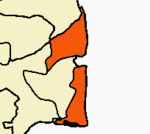History
According to the copperplate record of Chola king Rajaraja, the Sailendra king, Sri Mara-vijayottunga-varman constructed the vihara with the support of Rajaraja. The copperplate is in Leiden University (Holland). [4]
One statue, now at John D. Rockefeller Collection of Asian Art in New York, has an inscription that mentions that this Buddha was created to be carried in a procession during the temple’s sacred festival. The inscription has been translated by Vidya Dehejia as:
- Well-being [and] prosperity. The nayakar [Buddha], of all of the eighteen countries, of the metalworkers. The procession image, for the sacred festival of the alvar temple, which was caused to be taken in procession by the respected one (utaiyar) endowed of the four gunas from Cirutavur; [in] the perum-palli (great place of worship or great vihara) of the metalworkers, [in] the perum-palli of Rajendra Chola. [5]
Demolition :-
After 1870, the Chudamani Vihara, built by Raja Raja Chola I, was demolished by British Colonial authorities, despite opposition from members of Governor in Council - Elliot and Charles Traveleyn, due to pressure by Governor Napier and Christian Missionaries exiled by French Pondicherry Government.
This is subject matter of a Public Interest Litigation, filed by Advocate B. Jagannath, of the Madras High Court pertaining to repatriation of Leiden Copper Plates from Netherlands to India
This page is based on this
Wikipedia article Text is available under the
CC BY-SA 4.0 license; additional terms may apply.
Images, videos and audio are available under their respective licenses.
